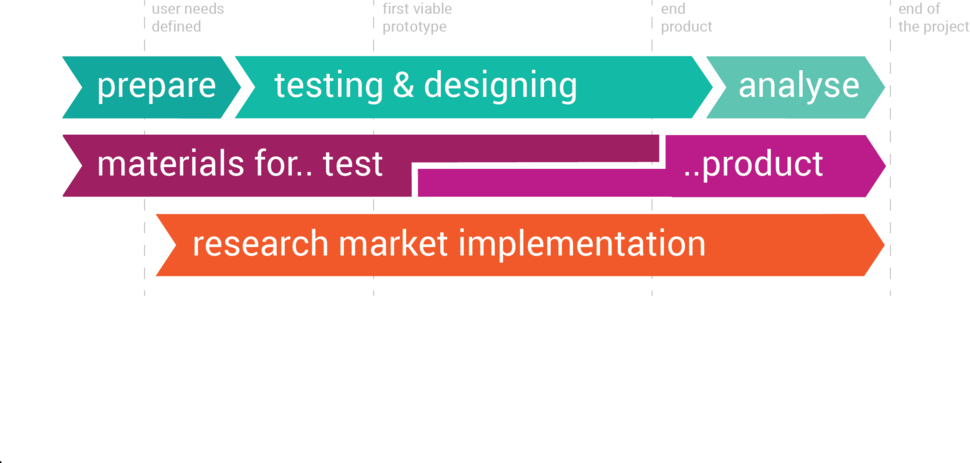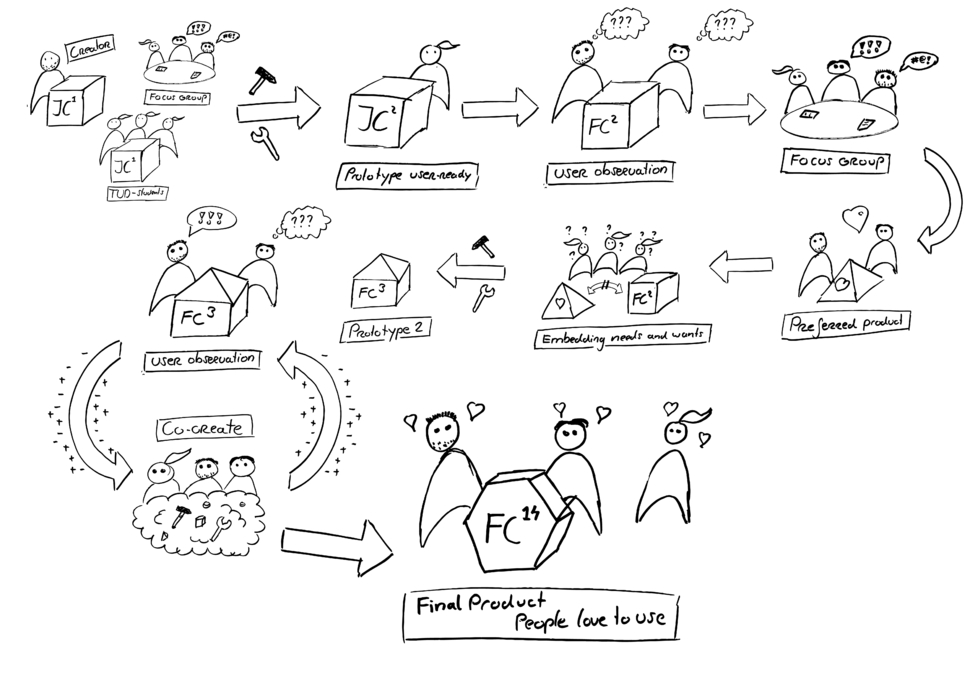First of all, it is important to acknowledge the use of a qualitative test rather than a quantitative one, considering that we’ll have to go in-depth with these tests in order to find out what kind of product would really fit our user. What you will read here is a summarized version of the test plan we will be executing on location.
Prepare
At this point, the current prototype of the Fortune Cooker is not yet suited for testing; there are too many actions that can’t be completed without an extensive manual. Therefore, we will test the product ourselves first, after which we will develop a prototype that is suitable for testing.
Simultaneously, we will do research on the user needs concerning cooking and all the activities associated with cooking. The user needs will be identified using two methods: the Krutus (verwijzing naar college) and either the Focus Group or an interview(descriptions in appendix …). The Focus Group has the objective to give a better understanding of what the users think and feel of selected - cooking related - topics. The ‘why’ and ‘how’ questions are important here. The Kroetoes will give insight in the desires and dreams of the users. If possible, we will try to implement findings of this research in the first prototype as well.
Testing & designing
Once the first prototype is ready for use, we will test it with our targeted user group directly. There’s a great chance that the users won’t use the prototype as we intended it to, but this is what this first test is for. By jumping in the deep at once, we can see what the user’s intuitive actions are. We will identify these by using the method User Observation (appendix …).
After the first test, a second Focus Group can identify what the conscious experiences of the user where, if they have specific wishes for the product, and whether their opinion on cooking in general has changed now that they know of the Fortune Cooker.
By combining the results of the Kroetoes, Focus Group 1, Focus Group 2 and the first user test, it possible make to make a description of what would be the ‘ideal product’. However, does this ideal product fit with the technical properties of the product? This is a where a new design phase starts. The ideal product and the technical product have to be combined into one viable product. During this process, it might be needed to perform small user tests, mainly focussed on the intuitiveness of the actions that have to be performed.The result of this second design phase is a new prototype…
That can be tested on the same users again. By testing on the same users as well as on new users we establish a process of co-creation: the users see their advice and experience implemented in a new prototype. This helps to them to trust the end product, but it also keeps the project interesting. (Bron die zegt dat co-creation helpt bij vertrouwen)
This test is followed by a next one with an iterated prototype, then another with the next version of the prototype, etcetera, etcetera, until we have a product the users and the designers believe in.
Analyse
The end product we have just discussed is designed to be suitable to the women living in rural Morocco. There’s no guarantee at all that it will work in another environment. For a successful continuation of the project, it is needed to analyse the extent in which the product is based on habits and needs specifically for the women in rural Morocco. What aspects of the product are essential for the performance of the product, and which aspects could be altered in order to make the product suitable for a different target group? An outcome could also be that the product cannot be altered to another target group without losing performance.
Materials
...for the prototype
During the project, we will retrieve the majority of the necessary materials from local suppliers. On top of that, we will strive to use mainly recycled materials. Searching for suppliers may take some time, plus there’s a chance that new prototypes require new materials. Therefore, searching and buying materials will probably prolong during the complete testing phase.
...for the product
As can be read in ‘Continuation of the project’, we have the aspiration to have the end product produced locally, with local materials. Contrary to finding materials for prototypes, the suppliers of materials for the end product should be able to deliver the materials for longer period of time, which makes the task somewhat more complicated. Also, the demands on the materials to be chosen for the end product are higher. After all, we are talking about a product that should last 21 years, according to the product patent (see appendix …). Once the first viable prototype has been developed, we can start searching of reliable materials and suppliers.
Research on market implementation
Once we have established that the Fortune Cooker is a product that people in the targeted area have a need for, we can start searching for possibilities to bring the product on the market. To start, we will map the customer journey(for an explanation of this method, see appendix …). The customer journey gives insight in all the stages the customer goes through before buying a product, which generally correspond with the five phases Osterwalder describes in Business Model Generation (Osterwalder, 2010). By being aware of the our customer’s journey, we can adapt the Fortune Cooker’s availability to the customer’s buying process. An even more thorough understanding can also enable us to influence the buying process.
Next to knowing the customer’s journey, it is important to know how we can produce the product locally, in order to keep the Fortune Cooker’s CO2-footprint as low as possible. Therefore, we will search for local producers, or search for possibilities to set up local workshops. By combining the customer journey and the local possibilities for production, resource obtainment and trade, we aim to find to best possibility for setting up an independent venture.

